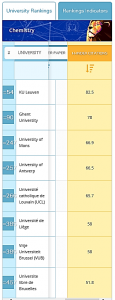RANKINGS: UMONS AMONG TOP BELGIAN UNIVERSITIES FOR SCIENTIFIC PRODUCT QUALITY
Two international university rankings have just been unveiled: the U-Multirank (1614 ranked institutions) and the “QS World University Ranking 2018” (4763 institutions evaluated). As in previous years, the University of Mons has again received very good results in terms of the quality of the productivity of its scientific publications, evaluated based on the number of publications referenced internationally and related to the number of researchers.
In U-Multirank 2018, UMONS finds itself in the top 200, and the second Belgian university out of 11, for the criteria “citation rate” (170th) and “publications most cited by peers” (175th).
UMONS is also in the top 40 (36th) for the publication rate in collaboration with other international institutions, and is the top Belgian institution for this criterion.
 Out of more than 4000 institutions evaluated, the “QS World University Ranking”, which is based on a slightly different methodology (read explanations on this topic at the end of the article), ranks UMONS 147th internationally for the citation rate and third in Belgium.
Out of more than 4000 institutions evaluated, the “QS World University Ranking”, which is based on a slightly different methodology (read explanations on this topic at the end of the article), ranks UMONS 147th internationally for the citation rate and third in Belgium.
Indicators related to the number of publications and citations are obtained from Scopus or Web of Science, two global bibliographic databases that identify and list scientific citations. These indicators objectively measure the quality of an institution’s scientific output.
The citation rate is the number of citations per published article. For UMONS to be around 170th in the world based on an objective and indisputable criterion reflects the “international recognition of the quality of our scientific output,” says Rector Calogero Conti.
In fact, as soon as the indicators are related to the size of the institution, UMONS achieves excellent results. It has achieved the highest possible score (A or Very Good) ten times for the criteria of External Research Income, Scientific Publications, Citation Rate, Most Cited Publications, Spin-offs, Publications Cited in a Patent, International Academic Staff, International Doctoral Degrees, International Joint Publications, and Master Graduates Working in the Region.
 If we examine the scores obtained last February in the QS ranking by field (Subject), based on the H-index, we can see that the three fields for which UMONS is ranked are in around 200th place worldwide. Indeed, among Belgian universities, Chemistry at UMONS is ranked 3rd, Physics 4th and Natural Sciences is equally ranked 4th . This H-index is a measure that simultaneously quantifies scientific productivity (the number of articles produced) and scientific impact (the number of citations). It can be applied to a person, a department or a university. An index of 67 for the field of chemistry at UMONS means that 67 articles have been cited at least 67 times each.
If we examine the scores obtained last February in the QS ranking by field (Subject), based on the H-index, we can see that the three fields for which UMONS is ranked are in around 200th place worldwide. Indeed, among Belgian universities, Chemistry at UMONS is ranked 3rd, Physics 4th and Natural Sciences is equally ranked 4th . This H-index is a measure that simultaneously quantifies scientific productivity (the number of articles produced) and scientific impact (the number of citations). It can be applied to a person, a department or a university. An index of 67 for the field of chemistry at UMONS means that 67 articles have been cited at least 67 times each.
As a reminder, U-Multirank is in its fifth edition and was implemented by the European Union. Unlike other rankings, U-Multirank is not a single score ranking as it classes universities by “rank” from “A” to “E”, on a scale from “very good” to “poor” in five key areas. These are research, teaching and learning, international dimension, knowledge transfer and regional commitment. For each domain, an institution is evaluated according to several indicators. With more than 30 different indicators, this ranking allows a fine analysis of the strengths of each of the 1600 evaluated institutions.
The “QS World University Ranking”, which is in its 14th edition, is published annually by Quacquarelli Symonds, a British company which specialises in education, and is one of three top university rankings, along with the Times and Shanghai rankings. It is based on six indicators: academic reputation (which accounts for 40%) and is based on the opinion of peers through a survey, awareness among employers and recruiters (10%), the number of citations per researcher (20%), quantitative supervision rate calculated on the basis of the teacher-student ratio (20%), the international student rate (5%), and the international teacher-researcher ratio (5%).
For more information on the QS Ranking, please visit: www.topuniversities.com/university-rankings and www.umultirank.org




